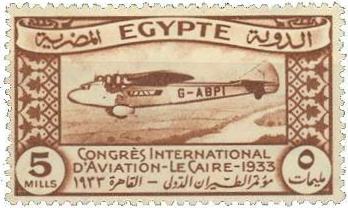 The 5 and 10 millime stamp form the set for the International Aviation Congress held in Cairo in December 1933 depict an Armstrong Whitworth Atalanta Aw.15. This Four engined high-wing 17-seat transport was built for Imperial Airways and Indian National in 1932. Spars and inner wing ribs were made from steel strip with the remainder of ribs and most of wing covering were of wood. The fuselage framework was constructed of steel strip formed into channels with the cabin area covered in plywood, while the rear of fuselage was covered in fabric
The 5 and 10 millime stamp form the set for the International Aviation Congress held in Cairo in December 1933 depict an Armstrong Whitworth Atalanta Aw.15. This Four engined high-wing 17-seat transport was built for Imperial Airways and Indian National in 1932. Spars and inner wing ribs were made from steel strip with the remainder of ribs and most of wing covering were of wood. The fuselage framework was constructed of steel strip formed into channels with the cabin area covered in plywood, while the rear of fuselage was covered in fabric
The tail unit was a monoplane cantilever type mounted at base of the fin which was faired into the fuselage. It had balanced elevators and rudder with the landing gear fixed undercarriage partially enclosed within the fuselage consisting of two axles hinged on the fuselage centreline and two telescopic struts fixed to the top longerons. It was designed to carry a maximum load of seventeen passengers and luggage, but this number was reduced in order to give each passenger the space and comfort necessary for travel in hot climates. The high-wing position enabled the passengers to obtain an unrestricted view. Technical detail are:
Length, 71 ft 6 in (21.79m) Height: 14 ft Span, 90 ft 0 in (27.43m)
Max speed, 156 mph (251 km/hr) at 3,000 ft (914 m) Cruising speed 125 m.p.h. Stall Speed, 51 m.p.h
Wing Area, 1,285 sq ft Weights Empty, 14,832 lb Weights Max, (All-Up) 21,000 lb (9,525 kg)
Climb, 21.5 min to 9,000 ft Service Ceiling, 14,200 ft Range: 640 miles
Engines, Four 340 hp Serval III 10 cylinder radials. Crew, Two pilots and a radio operator in cockpit Passengers, 9 with accommodation for up to seventeen.
Speeds of 120 or 130 mph were the usual, and aircraft usually flew no higher than 9,000 feet (although the Atalanta, a four-engine monoplane designed specifically for the mountainous regions of Africa, could reach 10,000 feet). By 1931 Imperial Airways had a fleet of 22 aircraft of various makes, none of which was really competitive. The mainstay aircraft was the Handley Page HP.42 which had a perfect safely record and a cruising speed of 100 mph. In the early 1930s these older airliners could not compete with the Fokkers and the Douglas DC-2s that were entering airline service with KLM and other airlines. Imperial Airways was hampered commercially by the restriction of using British aircraft only at this time. During the late 1930s the British aircraft industry attempted to catch up in the airliner market. Imperial Airways had placed a large order for the successful Shorts ‘Empire’ flying boat for it’s long-haul flights to Australia. While the airline was awaiting the new flying boats it needed a new airliner to fly the route to South Africa (Cape Town). The Armstrong-Whitworth Atalanta, which was specially designed for this route, filled the gap and flew the Cape Town route reliably until the new flying boats were introduced in 1937.
Atalanta, designations and names
G-ABPI Arethusa* 1932 Sold 1933
G-ABTG Amalthea 1931 Crashed, Kisumu 1938
G-ABTH Andromeda 1932 Withdrawn1939
G-ABTI Atalanta 1932 To RAF 1941
G-ABTJ Artemis 1932 To RAF 1941
G-ABTK Athena 1933 Burnt out, Delhi1936
G-ABTL Astraea 1933 To RAF 1941
G-ABTM Aurora 1933 To RAF 1941
* originally Atalanta later Arethusa